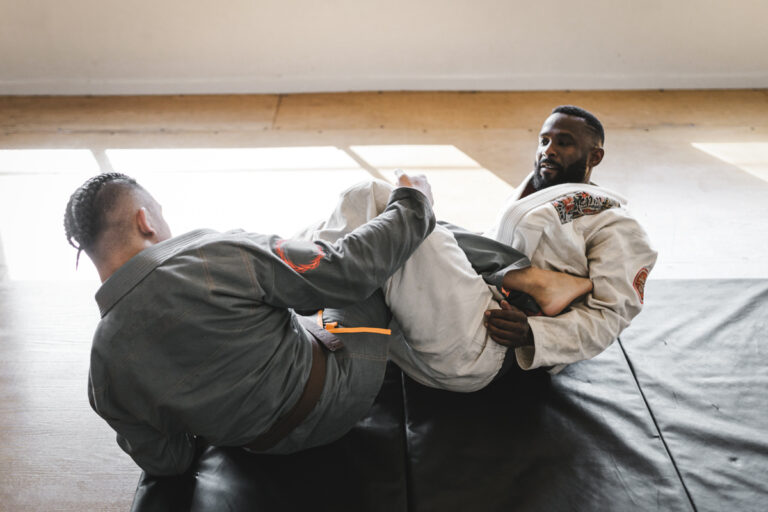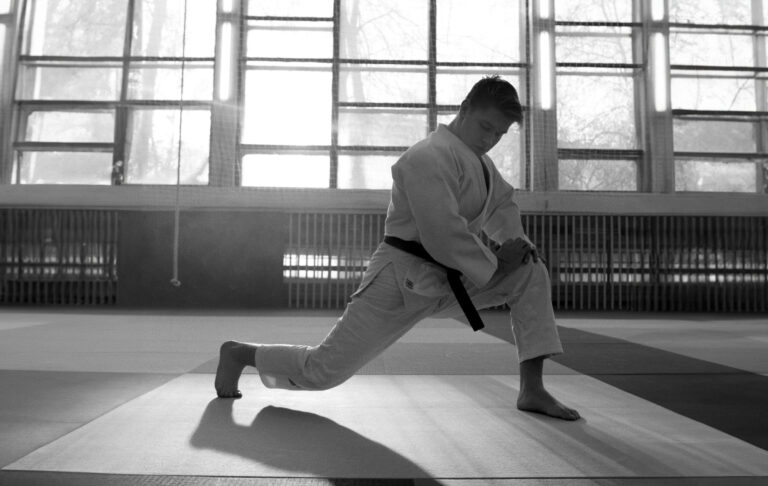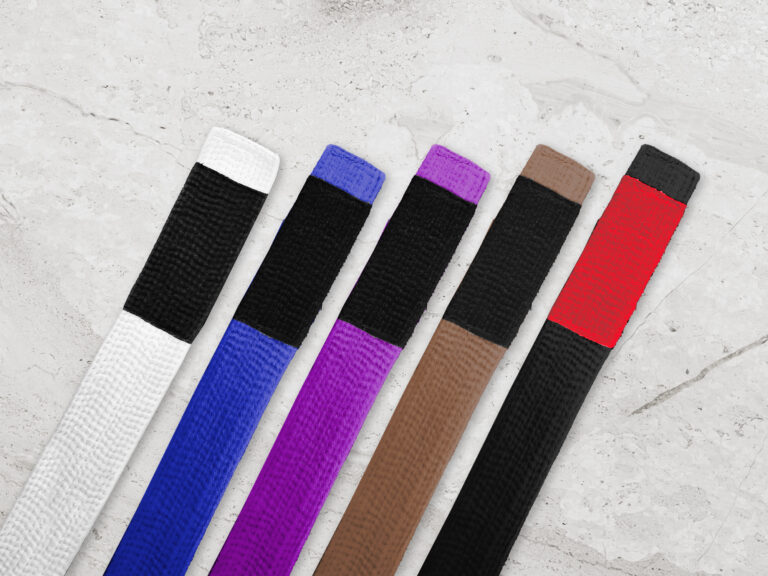Getting Started
Should I start gi or nogi?
Traditionally, most people would recommend starting with gi (in the traditional uniform), as it may require a better knowledge of technique and leverage. However, no-gi Jiu-Jitsu (without a uniform) is rising in popularity, and we are beginning to see more gyms open that are exclusively no-gi gyms. Ultimately, both are incredibly fun and effective, so we recommend trying both and focusing on the one you enjoy more.
What are the belts in BJJ?
White, Blue, Purple, Brown, Black. For adult athletes, the belts in Brazilian Jiu-Jitsu follow a progression from white to blue to purple to brown to black. Within each belt rank, you can earn white stripes that further signal progress. Typically, belts have a max of four stripes before you are eligible for promotion to the next belt, meaning a white belt with four stripes is eligible for a blue belt.
How long does it take to get a blue belt in BJJ?
1 to 2 years. This will vary based on your training consistency, skill development, and the school’s grading criteria, but athletes will typically earn a blue belt within 1 to 2 years. After that, each subsequent belt will usually take longer, ranging from 2-5 years to achieve each new rank.
How long does it take to become a black belt in BJJ?
The average time is anywhere from 8 to 15 years. This will depend on your training consistency, skill progression, and the requirements at your specific school.
Do you wear a cup for BJJ?
In training, this comes down to personal preference. The pros: you might avoid the occasional knee to the groin. The cons: it can be uncomfortable and hinder your movements. Just remember, most competitions do not allow cups, as they can create an unfair fulcrum point for submissions like the arm bar.
About Gi
How do I choose a BJJ gi?
Things to consider are color, fit, material, and design. For training, you have a lot more choices for each of these. But for competition, each organization will have its own set restrictions for gis. For beginners, we recommend choosing a solid white or solid black gi, as this will be acceptable at almost all schools and competitions.
For specific gi recommendations, check out The Best BJJ Gis of 2024.
Does BJJ gi color matter?
Gi color does not matter in terms of displaying a rank. There are many acceptable gi colors for training, including white, black, blue, green, pink, etc. However, certain competitions and schools have their own specific requirements for gi color. For example, international tournaments require gis to be white, black, or royal blue. So we recommend checking the requirements of your specific school or any competitions you plan to enter before buying a gi.
Can I wear a black gi as a white belt?
Yes. Gi color does not indicate rank. You can wear any color gi you want as a white belt, as long your school does not have its own requirements. The most popular BJJ gi colors are white, black, and royal blue, as these are accepted at almost every school and competition.
About noGi
Are there belts in nogi BJJ?
Yes. No-gi BJJ has belts just like gi, and no-gi schools do belt promotions just like traditional gi schools. However, unless someone is wearing a “ranked rash guard,” there is no way to tell an athlete’s rank in no-gi.
What to wear for nogi BJJ?
For no-gi BJJ, you should wear grappling shorts with either compression shorts or spats underneath and a rash guard on top.
How can you tell someone’s belt in nogi?
There is no way to tell someone’s rank in no-gi BJJ, unless they are wearing a “ranked rash guard,” which typically has a stripe or paneling in the color of their belt rank.
Miscellaneous
Who invented BJJ?
Brazilian Jiu-Jitsu (BJJ) was developed by the Gracie family in Brazil, particularly by Helio Gracie and his brother Carlos Gracie. They adapted traditional Japanese Jiu-Jitsu and Judo techniques to create a system that emphasized leverage and technique over brute strength.
Who is the best BJJ athlete in the world?
According to Flo Grappling, the best pound-for-pound athlete in the world for gi Jiu-Jitsu is Nicholas Meregali, and for no-gi is Gordon Ryan. Both athletes train under coach John Danaher at New Wave Jiu-Jitsu in Austin, TX.
Why is BJJ considered the best martial art?
Brazilian Jiu-Jitsu is widely regarded as the best martial art due to its dominance in the early days of the UFC, which had world champions from individual martial arts fight each other in a no-holds-barred contest. At UFC 1 in 1993, Royce Gracie represented Jiu-Jitsu and beat champions of boxing, shootfighting, and karate all in one night to become the first Ultimate Fighting Champion.



